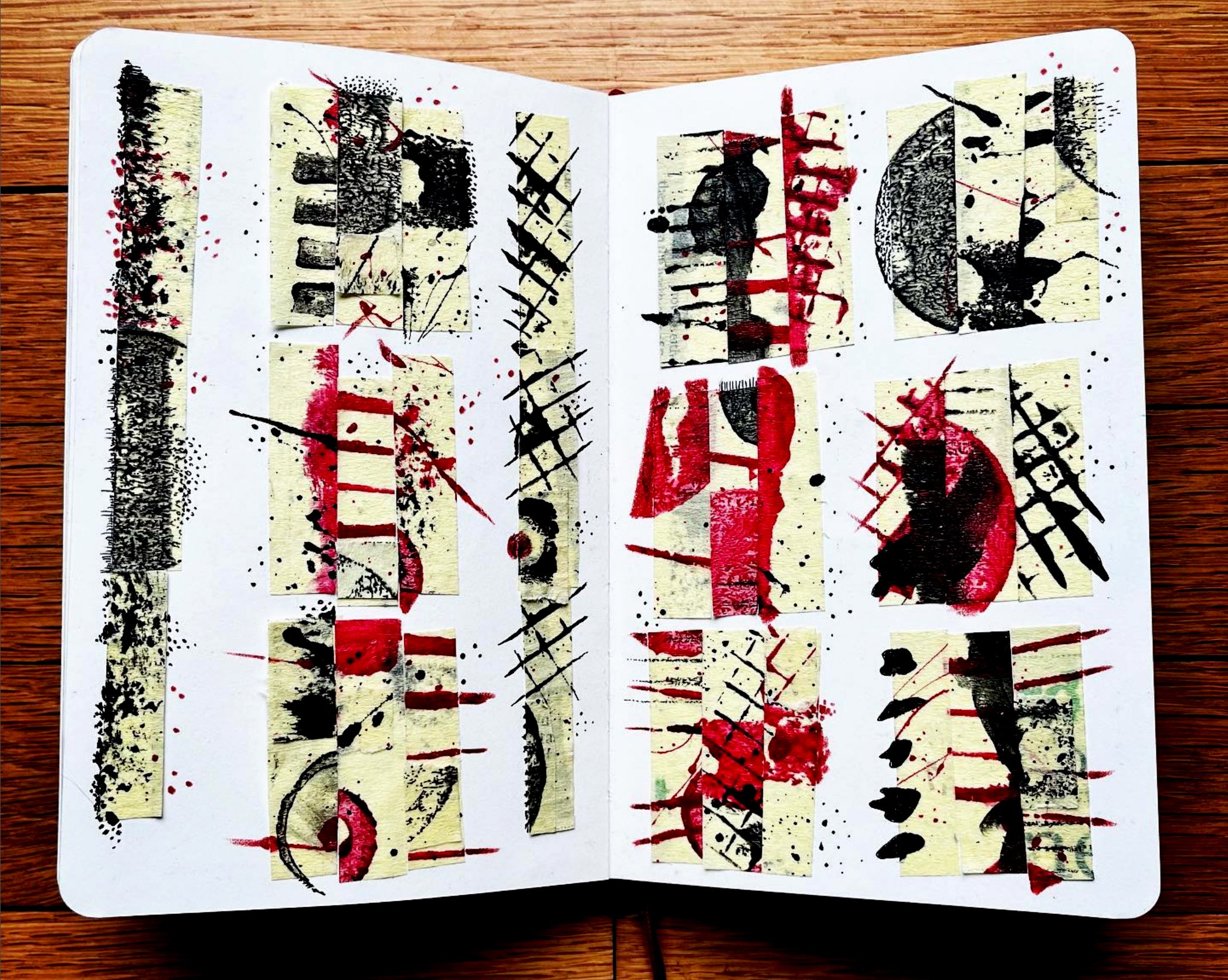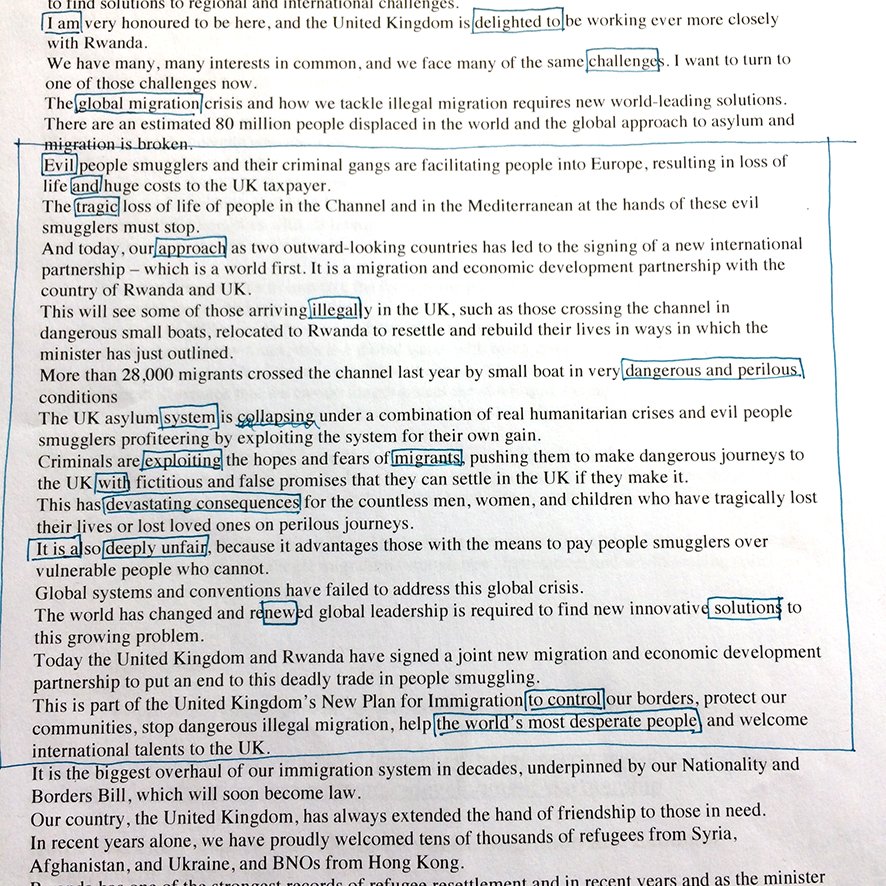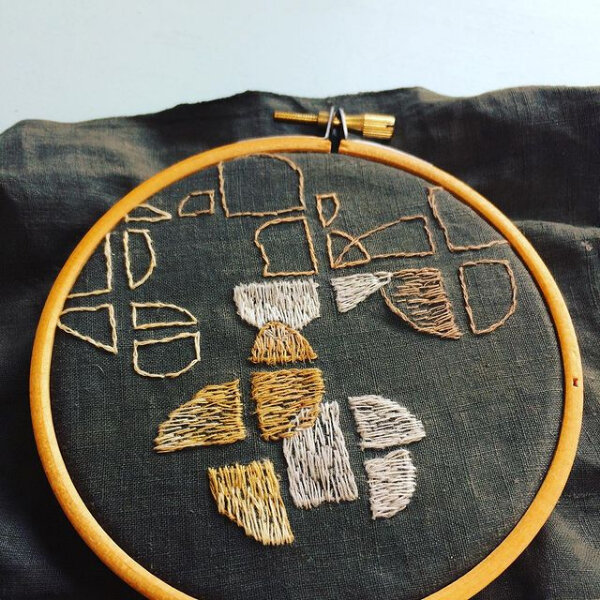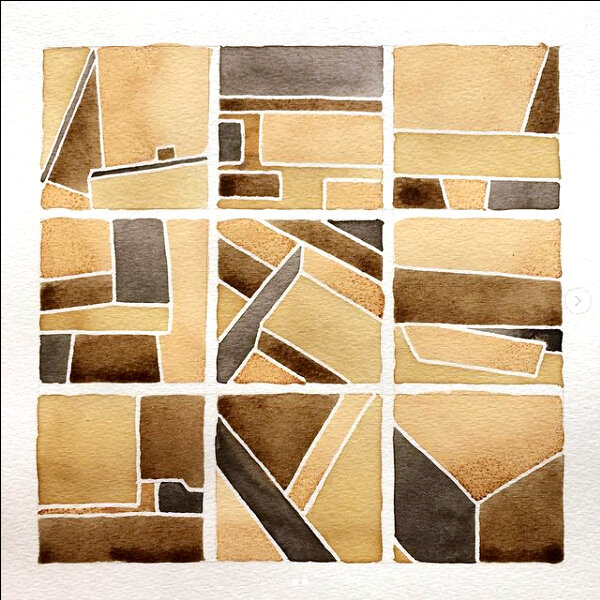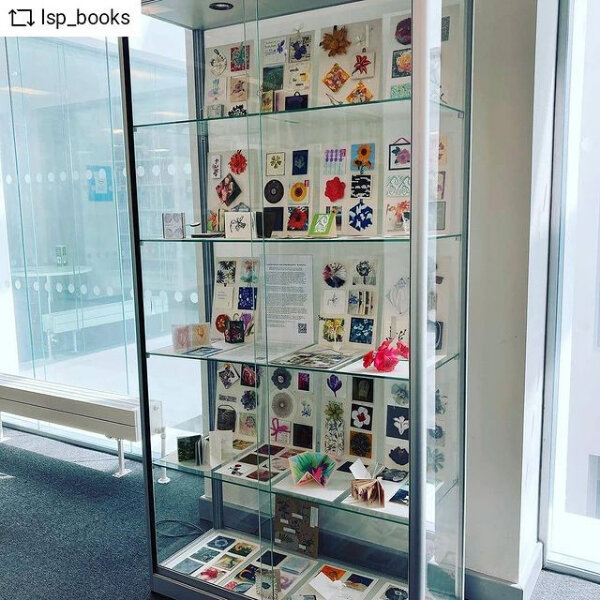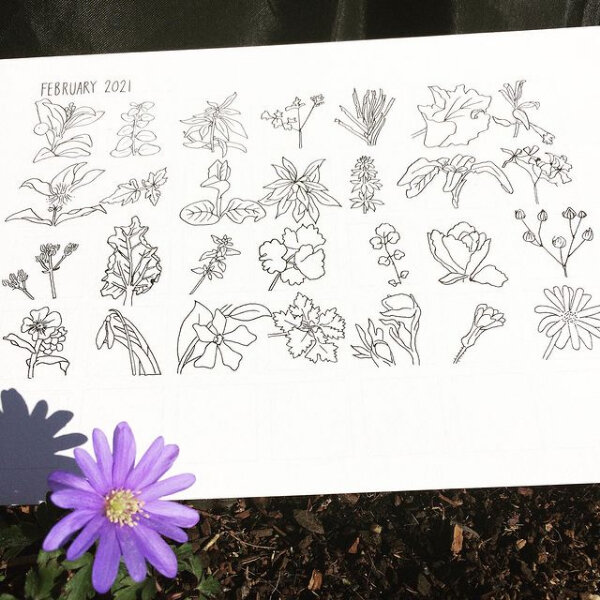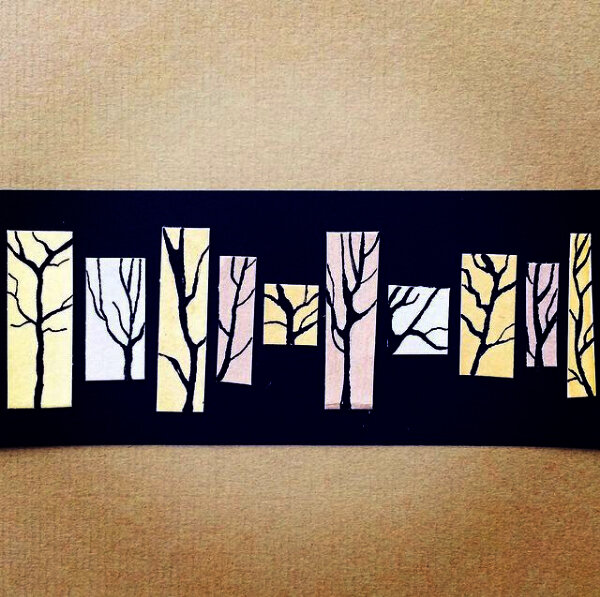Having fun stitching into circles punched out of my colour palette sheet for my daily drawings… as always, I’m baffled by my preference for working with the bits headed for the bin. I think it’s the random nature of the mark making and the transformation that comes from using punched shapes that is so appealing. Decisions taken out of my hands – the opposite of the control of my work as a graphic designer!
The Hand of Friendship
I am pleased to be able share some exciting news – an embroidered scroll I submitted to the Bodleian earlier this summer in response to a call-out has been awarded Second Prize! It will also be displayed as part of their exhibition ‘Beyond the Pale’ at the Old Bodleian Library in Oxford from 17 Sept – 6 November, and then be accepted into their permanent collection. I am over the moon!
The original call-out from the Bodleian Bibliographical Press in April was inviting artwork submissions that ‘respond to, and engage with, black shapes on the printed page’. I was intrigued by the subject matter, and thought immediately of heavily redacted government documents reluctantly released after Freedom of Information requests. I had been appalled by the recent announcement by the Home Secretary, Priti Patel, that the UK intended to start forcibly deporting refugees and asylum seekers to Rwanda. I decided to channel my anger into an artwork as a response to this shocking immigration policy.
I found a transcript of Priti Patel’s announcement online, and printed it out. After just a few minutes of highlighting words from the main body of the speech, I realised that a hidden – more truthful – message could be revealed through a reverse redaction. A printed redaction would have blocked out most of the text of the speech, but I wanted there to remain a sense of the wording in its original form to underline the incredulity that these were the actual words spoken by the Home Secretary. I decided upon embroidery as my chosen medium as I have an interest in ‘subversive stitch’ – using a traditionally domestic craft as an unexpected means of protest. I also felt that the dedication required for such a time-consuming method of working matched my strength of feeling about this important issue.
I chose to partially obscure much of the speech with lines of embroidered tally marks. These represented the thousands of individuals who faced deportation under this cruel scheme. I also wanted to reflect the dehumanising way that people can be reduced to target numbers when discussing immigration. I typeset and printed out a section of the original speech onto calico and then began the task of highlighting words by stitching the redaction in tally marks. The embroidery took around six weeks to complete – stitching most evenings after work. It proved to be a cathartic response to the some of the rage I was feeling about the injustice of this unethical policy.
I decided to make the final embroidery into a scroll – a format which highlighted the performative nature of the announcement… delivered, with some fanfare, in Rwanda as an illustration of the conspicuously ‘tough approach’ that the government wanted to be seen to be pursuing. Whilst I was completing the piece, the first planned deportation flight was halted after a last-minute intervention by the European Court of Human Rights. Although, at the time of writing, no flights have yet left the UK, relief is short-lived as the new Home Secretary, Suella Braverman, has reiterated her intention to continue with this inhumane scheme.
It has been proven that the threat of deportation is very damaging to the mental health of vulnerable migrants already here in the UK, but has certainly not been a deterrent to those subsequently arriving in the hope of claiming asylum. The scheme is prohibitively costly, and appears to exist primarily as a piece of populist theatre to placate the right wing press. It angers and saddens me to see our country reduced to this, and I know that this is not who we are.
I am happy to share my prize with Asylum Welcome, a charity I have worked closely with since 2005, whose amazing work with asylum seekers and refugees in Oxford very much provided the original inspiration for the artwork.
Week fifty two
And so ends the Garden Residency 2021!
One final collage of offcuts for the year
My small article in the latest issue of Printmaking Today
Penultimate dye experiment of the year – Yarrow (achillea)
December’s daily drawings - back-drawn monoprints with natural ink
And so ends my 2021 Garden Residency... it’s been a diversion, an excuse to experiment, some much needed structure, and license to play. A creative sabbatical. Accompanied throughout by my trusty studio assistant, Otto (a Vizsla of senior years).
One final collage of monoprinting offcuts before the year came to a close. If in doubt, cut out circles and arrange them in a grid. Always a useful creative un-blocker.
My last two dye experiments of the year are out of the dyepot... that makes 55 in total. Shown here is Yarrow (achillea) and I have Teasel drying at the moment. To be honest the colour palettes are very similar. A rather unexceptional end to a year of colour creation, but I’m looking forward to using some of the dyed fabric, yarn and thread from my dye experiments in new work next year.
In a piece of perfect timing, I received some exciting post on the penultimate day of this year-long project. I’m thrilled to bits to have a small piece on my garden residency in the latest Printmaking Today magazine. Many thanks to editor Leonie Bradley for including me in this issue.
My final month of daily drawings... 31 days of (rather splodgy) back-drawn monoprints coloured with natural ink (mostly marigold, black dahlia and oak twigs). As with all of the other eleven sheets, it’s interesting to see the overall effect as they accumulate through the month, rather than focusing on one drawing in particular.
I’m pleased to have completed my year-long challenge of a drawing a day, and I think I may have unintentionally made it into a habit (although I may reduce it to just weekdays as this is easier to build into my work schedule). Here’s to more drawing in 2022!
Amongst many other things, this Garden Residency has been a useful exercise in maintaining a weekly blog entry – based on my many Instagram posts throughout the year. I’ve really appreciated all the words of support, encouragement and feedback – it’s been a good way of feeling more connected during an otherwise isolated year.
I now need to finish recording my work in my journal, and take some time to consolidate and reflect, before working out my next steps. In the meantime, wishing everyone a happy and healthy new year... x
Week fifty
A leaf rubbing stitched with dyed linen thread
The four stages of the dye process (see below for details)
Coreopsis dye results
Playing around with my small stash of pressed leaves. I made a rubbing of a passionflower leaf, coloured it with an ink stamp pad, then cut it out and stitched it onto some Somerset paper using linen thread (dyed with carrot tops). Many of the leaves are too fragile to incorporate directly, but making rubbings seems to be a good way of reproducing them... more experiments needed!
I’ve been trying to clear some space in the freezer before Christmas, so there’s a flurry of dyeing activity, mostly with frozen flowerheads. I realised the different pans sat on my decking illustrated the various stages of the dye process:
1. Dried teasels soaking in water ready to be boiled into dye
2. Yarrow just boiled up, waiting to cool down before being strained
3. Strained sunflower dye with fabric, thread and yarn, cold soaking for a day before being heated up
4. Spent coreopsis dyebath, ready to be boiled down into ink
Finally, a welcome pop of colour on a grey December day – the results of dyeing with coreopsis. Gorgeous yellow flowers, deadheaded over the summer (and stashed in my freezer). They make a lovely range of oranges (turning brown with iron oxide). Something quite magical about creating colour in winter from flowers collected in sunnier times...
Week thirty five
My daily drawings for August - a collection of rubber stamp prints
The aforementioned rubber stamps!
An embroidered panel of naturally dyed wool
Limbering up for a month of daily drawings of gouache paintings
August has come to a close, and this month’s daily drawings are complete… all rubber stamps. This one has proved to be a little more time consuming, but they were mostly each completed within 15 minutes. Although it’s a technique I’m pretty familiar with, it’s still been a good learning exercise. Working out how best to simplify shapes, deal with negative space and incorporate fine details for stalks or petal markings. I now have a good stash of flowery rubber stamps that I can hopefully use in future projects.
Like the month of wax crayons, there’s a cohesion to the finished sheet of rubber stamps that comes from working with a set colour palette. I’m looking forward to mixing my own colours again next month though, when I’ll be using gouache for my daily drawings. I had a practice by doing a quick painting of a vase of flowers, and I think I’ll try to incorporate some coloured paper backgrounds to my daily drawing grid to make the inclusion of white flowers more possible.
As the month ended, I also finished a small embroidered panel I’ve been working on using naturally dyed yarn. I’m enjoying discovering the potential of embroidering with wool, relying on texture to build up a surface. It’s been a real pleasure choosing the colours and to see how they look together and interact with each other. There have been times over the past year when it’s felt like most of my dye results yield some form of ochre or brown, but this is encouraging proof that the palette is much wider than that.
Week thirty three
I finished my small embroidery based on drawings of viburnum flowerheads. Split stitch and French knots on linen. The third ‘tree’ is perhaps a bit light in tone, but it’s not an exact art when using naturally dyed thread. The linen was dyed with hypericum leaves (from under the viburnum tree in the garden) and the threads were dyed with sloes, bramble branches and Swiss cheese plant leaves. The first two from the garden, the last one from the house.
With a similar colour palette, I’ve been refining my plant form drawings… using India ink and teasel ink. I think these would work well in a small concertina book - all grids seem to point back to folded books at some point!
Common sorrel collected from a local field was one of the first plants I dyed with last summer, but I only dyed cotton lawn then, and had to wait another 12 months for the flowerheads to die back ready to be picked again. It was worth the wait - it’s a lovely, rich range of terracottas and browns, and the colour seems to take well across all materials. The woollen blanket has ended up the exact colour of my dog, so I may dye a larger piece as I like the idea of embroidering a line drawing of him.
Week thirty
Daily drawings for July – wax pastels
Teasels soaking ready to make into a dye
Scans of hydrangea petal skeletons collected from the garden earlier in the year
The first tree in my embroidery based on drawings of Viburnum flowerbuds
July comes to a close, and my sheet of daily drawings for the month is completed. I chose wax pastels as I haven’t used them very much before. With hindsight, this was a bit of a chunky medium to use for such a small scale… but this made me simplify my style and concentrate on bold shapes. Some worked better than others, but I am pleased with how coherent they look as a collection of drawings - I think it helps filling each square instea of leaving white space around the drawing. Next month - rubber stamps (back in my comfort zone).
Teasels I’ve grown from seed last year have turned into giants at the bottom of the garden (some around 3m tall!) They looked rather splendid and statuesques for a short period of time, but then after heavy rain and winds most of them have collapsed. So, in the spirit of ‘waste not want not’, I chopped up some of the flower heads from the fallen plants. An initial soak in hot water has already yielded an interesting bluey-green colour, so I have high hopes for the dye and ink that can be made from these casualties.
I finally got around to scanning some hydrangea petal skeletons I collected from the garden back in early spring. I was fascinated to see how much they looked like trees (or coral as suggested on Instagram). I’ve printed these out onto acetate and hope to use them to make a cyanotype when the sunshine makes a return visit. On the same them of ‘things that aren’t trees but look like they are’ I started my embroidery based upon drawings of Viburnum flowerheads I made last month. The linen is dyed with Hypericum and the thread is dyed with Sloes (+ iron oxide) - both from the garden. This is unusually neat stitching for me - I realised that wearing two pairs of specs allowed me to see detail much better!
Week twenty seven
Rubber stamping – a pattern based on my garden map
Shades of grey - planning for a new embroidery
Yarn embroidery based on natural ink drawings from a few weeks back
Dyeing with globe artichoke leaves
I revisited my original garden map drawings (see Week Nine) and made a repeat pattern rubber stamp tile. It didn’t work that well in black, but once I started playing around with it in colour, and adding extra patterned elements, it started to become more interesting.
I finished my yarn embroidery that was based on the natural ink drawings of shapes in the garden I did a few weeks back (see Week Seventeen). The fabric is woollen blanket dyed with ivy leaves, and the yarns are dyed with swiss cheese plant, black hellebore and lily flowers (with and without iron oxide). I like the tactile nature of embroidering with yarn, and the texture that can be created by stitching in different directions. I think the solid blocks of colour that can be achieved are also a more effective use of the yarn than crocheting. My next embroidery will be based on my drawings of budding viburnum flowerheads - I’ve been shortlisting greys for this from my naturally dyed stash of fabric and threads.
Finally, I dyed a batch of materials with globe artichoke leaves… a little underwhelming on fabric, but the yarn and threads took on pleasing yellowy green shades. I’ve harvested most of the fruits from the two plants, and have just left four for the bees.
Week twenty five
Completed embroidery with the original collage inspiration
Posca pen drawings of viburnum flowerheads
A pair of scarlet tiger moths in the garden
I finally finished my embroidery based on the collage I made earlier in the year from a sheet of natural ink samples. I like the translation from the random nature of both the original ink splodges and cut up collage pieces into a more permanent, structured form of an embroidery. The colours of the naturally dyed embroidery thread – which I must admit to feeling a little underwhelmed about at times – really comes alive on the dark background of the linen dyed with acorn galls + iron oxide. I’m fascinated by the mark making potential of stitches, and this is something I would like to explore further.
With the move between paper and fabric in mind, I did some drawings of viburnum flowerheads with a white posca pen. They make me think of an embroidery on linen with french knots… a new project to have in the pipeline.
A couple of rather exotic visitors to the garden last week… a mating pair of scarlet tiger moths on some red valerian. Not much scarlet on show, but their markings were beautiful, and I really enjoyed drawing them with watercolour and pencil crayons.
Week twenty three
Digital collage using papercut shapes and natural ink colour palette
Rhubarb on rhubarb
Daily watercolour sketches – purple Salvia
Another low production week – busy with work, under the weather with a cold still and spending lots of time watering the garden in this hot, dry spell. But still got a few things done. I enjoyed starting to use my new palette of colours based on natural ink swatches – I created a digital collage using papercut shapes and a rollered texture in Photoshop. Interesting to see how well the colours sit together, and they work well as semi-transparent overlays.
I used a short length of cordage made from rhubarb skin to add as a couched layer to a panel made from woolen blanket dyed with rhubarb root, and also layers of embroidery thread, linen and yarn dyed in the same dye batch. I’m not that pleased with the composition (it’s meant to be based on rhubarb leaves but it looks like hearts or a map) but I like the idea of making stitched panels linked back to the original plant source of the colour. This one needs a bit more thought…
I’m stepping outside of my comfort zone this month for my daily drawings – using watercolour (a medium I am not experienced with using). It’s finally a good opportunity to record some of the colour in the garden, which has finally started to bloom over the past week. Everything seems about a fortnight behind this year, but many plants are now catching up quickly. So lovely to have some sunshine to accompany the colour after such a cold, wet Spring. Salvias are one of my favourite flowers, and the bees are going crazy for them at the moment too…
Week twenty two
May’s completed sheet of daily drawings
Work in progress - an embroidery based on a collage I made of natural ink samples
Natural dye results from lavender prunings
A lower production week as I’ve been a little under the weather with a cold (rather frustrating just as the sun finally makes an appearance). I completed my daily drawings for the month of May - coloured pencil drawings of leaves. I delayed moving into full-on full colour as the cold Spring we’ve been having here in the UK has meant that a lot of flowers are much later to come out this year. So greens it has been - I’ve really enjoyed looking at the different shapes of leaves and tones of greens… always a relaxing way to begin the day.
I’ve made a good start on a new embroidery - this one is based on a collage I made earlier in the year from a test sheet of natural ink samples. I’ve enjoyed translating the uneven shapes of the ink blobs into stitch, and matching the colours of naturally dyed threads to create a similar palette. The colours are soft but they really do pop on this dark grey lined (dyed with acorn galls and iron).
Finally, another set of dye results from using prunings of lavender bushes from the edge of my veg patch. The branches were dead, so I wasn’t sure what (if any) colour could be extracted. It won’t set the world on fire, but I was surprised how much colour was there, especially on the yarn and woollen blanket squares.
Week twenty one
My finished garden map embroidery
Drying strips of rhubarb skin for making cordage
Colours from purple hazel
A year of natural dyeing experiments
A digital colour palette based on scans of natural ink samples
Pleased to announce I’ve finally finished my embroidered garden map! It was hard to know when it was complete - very tempting to keep tinkering and adding features. All the fabric, thread and yarn used has been naturally dyed, mostly from plants and trees in the garden itself. A pleasing symmetry. I’ve really enjoyed working on this, and especially liked using single strands of yarn for the embroidery – this enabled me to expand the colour palette as the naturally dyed embroidery thread is a lot more limited in its range.
The rhubarb is in full flow in the garden – particularly after all the rain we’ve had this month – so I decided to strip some skin from stalks to dry for making cordage. It will be interesting to see if the pink colour lasts once it’s dried.
My natural dyeing experiments have slowed down considerably as there’s more need to be actually gardening at this time of year – I think it’s best suited to autumn and winter. I had some purple hazel leaves trimmed from stakes I used to make a sweet pea wig wam recently, so I decided to see what colour could be extracted. Nothing amazing, but a nice range of natural colour.
May 28 marked a whole year since my first natural dyeing experiment. I laid out all of my dye sample cards to mark the occasion with a photo to mark my progress. It’s been such an enjoyable rabbit hole to have fallen down, and learning through doing is always my favourite way to pick up new skills. There are precious few upsides to a global pandemic, but the increased amount of time I’ve had at home through all of the various lockdowns has afforded me the space to explore something that has fascinated me for a long time.
And finally, a digital colour palette based upon scans of my natural ink samples… I’m not sure exactly what I’ll do with this, but I’m hoping it will help me to bridge the visual gap between my analogue and digital work.
Week eighteen
Work in progress on my stitched garden map
Dyeing with nettle tops
Dyeing with hornbeam catkins
Using up leftover ink on a leaf pattern
Not so much time for creating at the moment as most of my spare time is being spent tending to seedlings, potting and working in the garden. I’m making good progress on my stitched map of the garden… I decided to use single strands of yarn for the trees and shrubs as I have a much wider range of greens to play with from my naturally dyed stash. The trickiest thing is knowing when to stop - what detail to add and what to leave out. Definitely nearly there though.
Two very different dyebaths this week - soft greens from nettle tops, and yellows/greys from hornbeam catkins (not from the garden but swept up from the pavement at the end of my road).
Quite fun using up some ink from a job to make repeat shapes, turned into leaves with a dip pen once dry. All roads lead back to drawing plants in some form or another at the moment!
Week sixteen
Natural ink drawing, based on photos taken in my garden (see below)
Black hellebore flowers make a lovely green dye and ink
Planning out an embroidery based on a collage of natural ink splodges
Drawing seedlings
My World Book Night 2021 entry to the Herbarium
The Herbarium on display in Bower Ashton library (photo ©Linda Parr)
Working with grids (again!) this week. I took some photos of different shapes in the garden – mostly steps and decking – and traced these off to make a masked drawing with natural ink. The ink used was rhubarb root, bramble and acorn gall (with and without iron). This feels like a starting point rather than a finished piece, so I’m looking forward to developing this further.
I dyed with black hellebore flowers… only a small batch but enough to see that it gave the best green I’ve managed to achieve yet. It also boils down to a good ink.
I re-visited a collage made a couple of weeks back from my ink sample sheets – I isolated a section of this and have traced it off to make a small embroidery. Quite pleasing to see that a similar palette could be chosen with the naturally dyed threads. I think this will work well on linen.
In between tending to my seedlings (currently taking over the spare room, cold frame and greenhouse) I’m enjoying drawing them in a tiny coptic-bound sketchbook given to me by Eva Hejdström.
Finally, Friday was World Book Night and it was a pleasure to take part again in the annual call for entries to mark the occasion. This year a Herbarium has been created – an exhibition of literary-inspired flower illustrations in Bower Ashton library. My illustration of periwinkles was inspired by a poem called ‘A Tale’ by Edward Thomas. These flowers are my nemesis in my garden… it’s an ongoing battle to stop them swamping everything, so it was good to pause and appreciate the beautiful flowers before I start yanking them up all over again! A pdf catalogue of the Herbarium can be downloaded here. Many thanks to Sarah Bodman and Linda Parr for organising this wonderful collaboration.
Week fourteen
A flag book of natural ink samples
Ink sample flags, labelled on the reverse
Some lovely pinks and browns from a defunct rubber plant
Making good progress on my latest garden map
Drawing more on my week off - a young apple tree from the slope in my garden
Pencil crayon sketches of Spring flowers from the garden
A relaxing week off work – although just spent at home as lockdown continues, I enjoyed having a bit more time to draw and develop some of my recent projects. I finally finished my flag book of ink samples… a few false starts, and it was a bit of a headache keeping track of the labelling, but I’m pleased with how it’s turned out. The flags are made from such heavy paper that it makes a lovely click-clack sound when opened.
I’m very happy with the colour range extracted from a recently defunct rubber plant. I made three dye baths… from the leaves, the branches and the roots. The roots were the palest colour, but the leaves and branches gave quite similar results. I’m hoping this is a more stable pink colour than those I’ve managed to extract previously from berries.
I made good progress with the latest iteration of my garden map. I cut out all the components from my stash of naturally dyed fabric, and bonded it onto calico. This is now ready to start embroidering.
Despite the unseasonably cold weather, I braved some time sat outside in the garden drawing with ink and coloured pencils. I’m determined to continue carving out a bit more time for drawing - slowing down and close observation is making me appreciate the garden so much more. Good to capture some of the Spring colour before it disappears until next year.
Week eight
Rubber stamp pattern experiments based on a line drawing of lavender
Starting to crochet up small squares of dyed yarn to create a sampler
Results of dyeing with Hypericum (St John’s Wort) – a good range of colour, much stronger on wool
Finished my stitched fabric collage - bit wonky but good to see what colours go together
A welcome injection of colour – cranberries in the dye pot
Printing my woodcut
February’s daily drawings complete… a month of line drawings with flowers starting to make an appearance towards the end
Felt like the start of Spring this week… mornings are still cold and frosty, but sunshine and blue skies during the day really lifted the spirits. Quite a bit of dyeing going on in the background - should be able to show the results next week… I’m hoping some of the vibrant pink from frozen cranberries left over from Christmas will remain after rinsing. I’ve enjoyed making more rubber stamps to experiment with pattern - I’m going to try to do at least one of these each month so I have a set of patterns by the end of the year. I finished stitching onto my collage of fabric offcuts - it’s pretty rough around the edges, but I quite like the mark making of the stitches, and it’s good to start working with some of the dyed materials and see how the colours work alongside each other. I’ve also started crocheting some small swatches of the dyed yarn (remembering to label them as I go!) so that I can eventually put together a sampler. I completed my month of daily line drawings… it was interesting to see more flowers appearing by the last week of February, so that should bring more inspiration for future months.
Week four
Speed drawing in my front garden… red cabbage ink, wax crayon, caran d’ache water soluble crayon and India ink.
Wax resist ink drawings based on photos on branches in the snow taken in the brief window of white stuff on Sunday morning
Ink drawing of a Viburnum branch - colour rubbed from the actual berries and leaves
Collage of natural ink offcuts with drawings of fruit tree branches
A neater version of the stamped pattern I created a couple of weeks ago for covers on a coptic bound sketchbook. The linen thread is dyed with red onion - a perfect match for the ‘pear tart’ ink stamp pad
Experiment with stitching onto paper. Naturally dyed linen thread over the top of the corresponding homemade ink. From left to right: onion skins, hawthorn, holly berry and eucalyptus bark
A close up of the holly berry circle… this is my favourite ink so far - a really rich colour
Another productive week… my ‘garden residency’ seems to be balancing well with my day job so far - by doing something every day, I find I get into a rhythm of working and can maintain some momentum. This first month has been a lot of trying things out, but having just spent a day pulling everything together into a large scrapbook to record my progress, I’m happy with how it’s shaping up. Results have been a bit hit and miss, but I’ve learnt a lot and had fun getting back to playing again. It’s certainly been a welcome distraction in a particularly bleak January, and has left very little time for feeling bored or hemmed in at home.
Stitching something other than books
Completed just on time (as always) an embroidery for the very grand occasion of my mother-in-law’s 80th birthday in early July. Original flower designs by Yumiko Higuchi, adapted from his excellent book ‘Zakka Embroidery’.
Redesigned Medieval Books come to Bristol...
A sneak peek at one of the cabinets
Signage and labels before assembling the exhibition
My embroidered book 'Remedie' is on show in this exhibition
Very pleased to announce the opening of the 'Redesigning the Medieval Book' exhibition at UWE Bower Ashton Library in Bristol. The display is an extension of the original exhibition at the Bodleian Library in Oxford earlier this year, and features 40 new books and artworks created in response to the Bodelian's collection of medieval books and manuscripts. I'm very grateful to Professor Daniel Wakelin and all the team at the Bodleian Library for their help in facilitating this extended exhibition, and to Sarah Bodman at UWE and fellow book artist Kate Bernstein for their help and support in setting up the exhibition. It will run from 19 April - 29 June, and there will be an informal 'show and tell' event on Saturday 12 May, 12-2pm, where you can hear some of the artists talking about their books and working process. If you can't visit the exhibition, you can download or view a pdf of the catalogue here.




